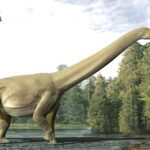A team of researchers have used DNA from ancient eggshell fragments to provide a rare glimpse into the evolution of Madagascar’s extinct elephant birds.
Published in the Journal Nature Communications, the team examined 1000-year-old fossil eggshells and found that genetic differences in these gigantic birds, which reached three metres in height and weighed over 500 kilograms, were linked to eggshell thickness, location, and diet.
Lead researcher Dr Alicia Grealy, who completed the research in Curtin’s School of Molecular and Life Sciences and is now based at CSIRO, said this monitoring tool allowed the team to gain a deeper understanding of this fascinating bird species which walked the Earth thousands of years ago.
“The team collected more than 950 eggshell fragments from across Madagascar. Molecules preserved in some of these eggshells helped us discover a potentially new sub-species which lived in the top end of the country. We were also able to determine that different species ate a mixture of grass, shrubs and succulents,” Dr Grealy said.
“Another surprising finding is that the gigantic size of the largest elephant birds (Aepyornis maximus) likely arose within the last 1.4 million years, alongside the changing environment and ecosystem in Madagascar. This species nearly doubled in size over a very rapid and recent time frame.”
Dr Grealy explained the research findings were an important leap forward in resolving the complex history of some of the world’s largest ancient birds.
“It is amazing to think that these thousand-year-old egg fragments can give us insight as to where elephant birds lived, what they ate, how their ancestors might have looked, and how they evolved over the years,” Dr Grealy said.
“The findings contribute to our understanding of how elephant birds lived and functioned within Madagascar’s unique ecosystems, and also reinforces how ancient DNA from eggshells is a promising avenue for studying the evolution and extinction of giant animals.”
The paper was also co-authored by researchers from Curtin’s School of Molecular and Life Sciences, University of Colorado, QUT, Integrity Ag and Environment, University of California Riverside, The University of Western Australia, University of Turin, University of Copenhagen, University of Cambridge, The University of Texas at Austin, Columbia University, Zoological Society of London, and Oxford University.
The paper is titled, ‘Molecular exploration of fossil eggshell uncovers hidden lineage of giant extinct bird,’ and can be found online here.



